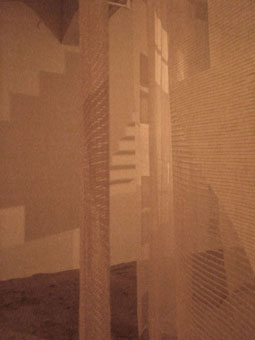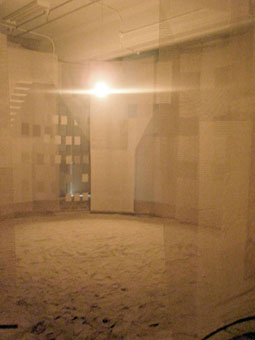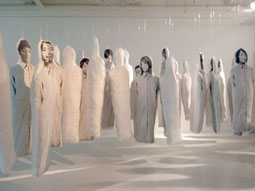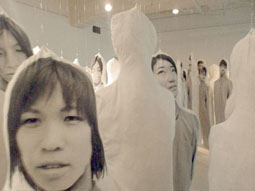 |
|
 |
| Shadows of a phantom city |
|
Mound of sand lit by a single bulb |
|
Since the end of the Second World War, Japan's cities have increasingly succumbed to the "donut effect." The population shifted to the outer suburbs as inner city rents rose, and inheritance taxes forced families out of homes they had owned for generations. The sites were sold to developers and the city turned over to business and commerce. One side effect was a large number of downtown elementary schools without students and soon abandoned. Often fine pieces of architecture, exemplifying the hybrid Japanese-Western style so popular in the late-nineteenth and early-twentieth century, the best of them are now used as venues for art and cultural events. Their standardized combinations of corridors, classrooms and halls, with generous outdoor playgrounds enclosed by the building wings, provide an extremely versatile backdrop.
Located in the center of Kyoto, the Meirin Elementary School was established in 1869, reconstructed in 1931, closed down in 1993, and reopened in 2000 as the Kyoto Art Center, its former classrooms now functioning as galleries, studios, an information hub, an auditorium, a cafe, and so on. The Center makes a point of supporting young artists, offering three-month residency programs and sponsoring an annual competition for installations in the main gallery spaces. This year's Kyoto Art Center Public Contest 2009 (the eighth such event so far) was judged by playwright and theater director Oriza Hirata. From 82 submissions in an open competition, he selected two works that address the spaces of the school and the bodies of viewers in innovative ways.
In the North Gallery, Yui Inoue (born in 1983 and a graduate of the Kanazawa College of Art) has created an installation titled "Kokuu ni Ukabu Tsuki" (Moon Floating in Empty Space). Entering from the outdoors, the room appears completely dark until your eyes adjust. The installation comprises a low mound of fine-grained sand on the floor with hanging sections of open-weave fabric outlining a circular space in the square room, lit from above by a single naked bulb. Shapes woven into the fabric produce strange shadows on the walls, reminiscent of building profiles, window patterns, stairways -- a phantom city that appears to expand beyond the confines of the room.
In the South Gallery, a pair of artists calling themselves "clipper" (Hanako Washio and Teruko Mizutani, both born in 1982 and both graduates of the fashion design course at the Kyoto University of Art and Design) have created a simulation of a crowded train. Entering the space through a black curtain, you immediately find yourself pushing your way through a crowd of people. Though initially quite unnerving, this turns out to be 132 life-size dolls hanging from the ceiling, each a simple fabric form printed with a monochrome photo of a person. On the far wall is an endless video projection of scenery moving by, as if from the windows of a train.
Whatever their artistic merits, by engaging the ways the existing spaces of this former elementary school can be experienced -- one attempting a perceptual expansion, the other exacerbating compression and density -- these two works hint at ways that architectural heritage might be revived without undue reverence, and with a sense of humor.
 |
|
 |
| Crowd of people on a train |
|
Printed with life-size photos |
|
|